The Official Railway Guide is an essential resource for travelers, providing detailed information on railway systems, routes, and schedules worldwide. It assists in planning journeys efficiently.
Overview of Railway Guides
Railway guides are comprehensive resources that detail train routes, schedules, and services worldwide. They help travelers plan journeys efficiently, offering insights into ticket booking, station layouts, and scenic routes. Whether printed or digital, these guides cater to both tourists and regular commuters, ensuring seamless navigation of railway networks. They often include maps, timetables, and travel tips, making them indispensable for exploring destinations by rail.
Importance of Railway Guides for Travelers
Railway guides are vital for travelers, offering detailed route maps, schedules, and service information. They enable efficient planning, helping users select the best routes and avoid delays. Guides also highlight scenic routes, stations, and nearby attractions, enhancing the travel experience. For international journeys, they provide language support and cultural insights, ensuring seamless navigation. By offering real-time updates and ticketing options, railway guides empower travelers to make informed decisions and enjoy stress-free journeys.
History of Railway Guides
The Official Railway Guide traces its origins to the 19th century, evolving alongside railways to standardize operations and inform travelers. It remains a cornerstone of railway navigation;
Evolution of Railway Systems
Railway systems have transformed significantly since their inception, from steam engines to modern electric and high-speed trains. The introduction of standard gauge lines and automation technologies has enhanced efficiency.
Sustainability efforts, such as electrification and hybrid trains, are reshaping the industry. The Official Railway Guide documents these advancements, reflecting the gradual shift toward smarter, greener, and safer railway operations globally.
Historical Development of Railway Guides
Railway guides originated as simple timetables, evolving into comprehensive resources for travelers. The first guides emerged during the 19th century, detailing routes and schedules. Over time, they incorporated maps, fare information, and travel tips. Technological advancements, like digital platforms, transformed these guides into interactive tools. Today, official railway guides remain essential for planning journeys, reflecting the industry’s growth and adaptation to modern traveler needs.
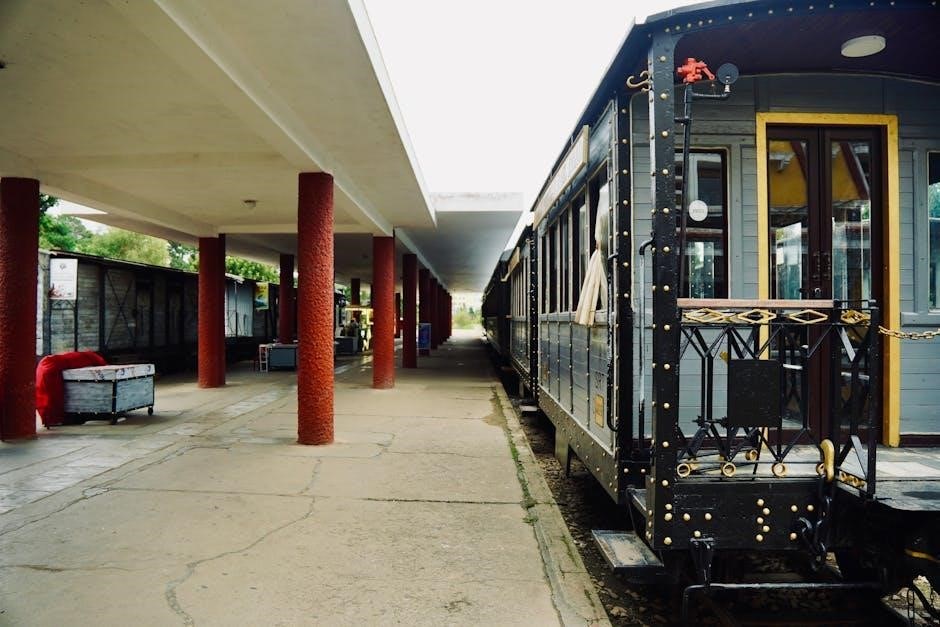
Types of Railways
Railways vary by purpose, including passenger, freight, and high-speed systems. Each type serves distinct needs, ensuring efficient transportation of people and goods across regions and countries.
Passenger Railways
Passenger railways are designed for transporting people, offering comfort and convenience. They include urban transit systems and long-distance trains, often equipped with amenities like seating, restrooms, and food services. Many systems provide scenic routes, making travel enjoyable. For instance, the Bernina Express offers breathtaking views, while high-speed trains like those in Japan prioritize efficiency. Passenger railways are a popular choice for both daily commutes and leisurely journeys.
Freight Railways
Freight railways specialize in transporting goods and materials, playing a crucial role in global trade. They handle bulky items like steel, coal, and machinery, often over long distances. Efficient and cost-effective, freight railways reduce road congestion and emissions. Advanced systems use standardized containers and specialized wagons, ensuring safe and timely delivery. This sector is vital for economic growth, supporting industries and connecting markets worldwide with reliable logistics solutions.
High-Speed Railways
High-speed railways operate at speeds exceeding 150 km/h, revolutionizing land travel. They combine advanced technology, streamlined trains, and dedicated tracks for efficiency. Routes like the Bernina Express and Japan’s Shinkansen exemplify this. These systems reduce travel time, offering comfort and reliability. Environmental benefits include lower emissions, making them a sustainable option. High-speed railways connect cities, boost economies, and enhance passenger experiences globally, showcasing modern rail travel’s potential for speed and sustainability.
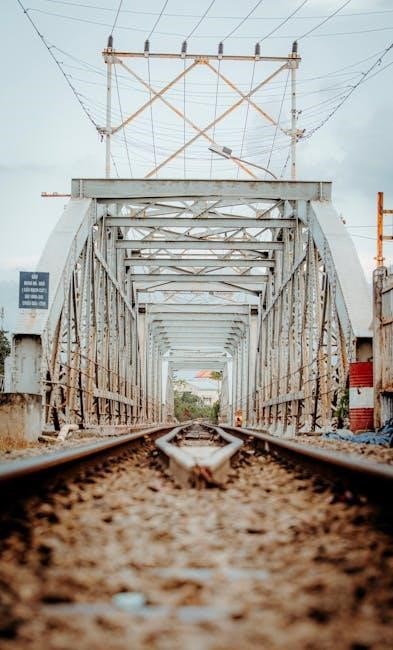
Planning Your Railway Journey
Planning your railway journey involves selecting routes, checking schedules, and booking tickets. Guides offer tips for scenic routes like the Bernina Express, ensuring a smooth travel experience.
How to Choose the Right Route
Choosing the right route involves considering personal preferences and practical needs. Popular routes like the Bernina Express offer scenic views, while others prioritize speed and direct connections. Check schedules, distances, and attractions along the way. Maps and reviews can help identify routes with cultural landmarks or vibrant markets. Prioritize routes with convenient stops and amenities. Ensure the route aligns with your travel goals, whether exploring new destinations or efficiently reaching your final stop.
Understanding Railway Schedules
Understanding railway schedules is crucial for seamless travel. Schedules detail departure and arrival times, frequencies, and stops. Plan your journey by checking real-time updates and delays. Use online tools to filter routes by speed or cost. Peak hours may affect availability, so book in advance. Familiarize yourself with platform changes and transfer times. Schedules vary by season, so always verify before your trip. Tools like journey planners can help optimize your travel experience.
Booking Tickets Online
Booking tickets online is a convenient and efficient way to secure your travel plans. Most railway systems offer user-friendly websites and apps for ticket purchases. You can browse schedules, select seats, and pay securely. Online platforms often provide discounts for early bookings or loyalty programs. Ensure to verify your personal details and payment information before confirming. Some services allow ticketless travel with digital passes. Always check for promotions and flexible ticket options to suit your needs.
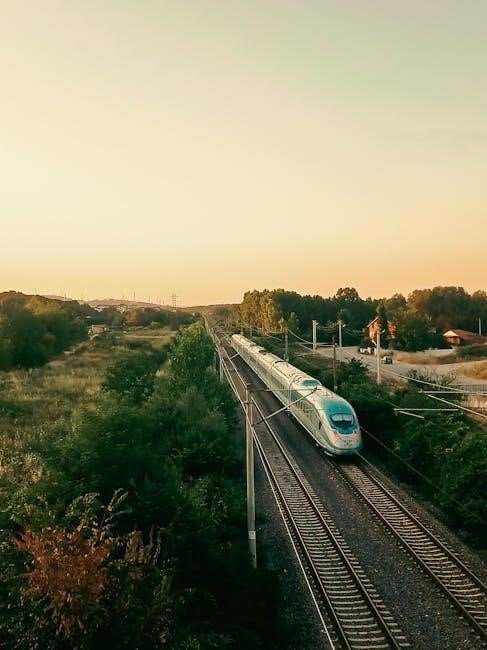
Popular Railway Routes
Popular railway routes connect major cities and scenic landscapes worldwide. Iconic routes include the Rocky Mountaineer, Glacier Express, and Eurail networks, offering breathtaking views and cultural experiences.
Scenic Railway Routes
Scenic railway routes offer breathtaking views, combining travel with nature’s beauty. The Bernina Express, a UNESCO World Heritage route, traverses the Swiss Alps, while the Rocky Mountaineer in Canada showcases stunning mountain vistas. The Glacier Express in Switzerland and the Blue Train in South Africa are also renowned for their picturesque journeys. These routes attract travelers seeking unforgettable experiences, blending cultural exploration with natural wonders. They are ideal for photographers and nature enthusiasts, providing a unique way to explore diverse landscapes.
International Railway Routes
International railway routes connect diverse countries, offering cultural and scenic experiences; The Bernina Express links Switzerland and Italy, while the Tema-Mpakadan Railway in Ghana enhances regional connectivity. These routes provide a unique way to explore multiple destinations seamlessly. Travelers can enjoy varying landscapes and immerse in different cultures. International routes are popular for their convenience and the opportunity to witness global heritage, making them a favorite among adventurous travelers seeking unforgettable journeys across borders.
Railway Safety and Security
Railway safety and security are critical for protecting passengers and staff. Measures include surveillance, emergency protocols, and staff training to ensure a secure and reliable travel experience.
Safety Measures for Passengers
Safety measures for passengers include emergency braking systems, fire alarms, and surveillance cameras. Passengers are advised to follow station rules, keep belongings secure, and stay alert near platforms. Regular drills and staff training ensure quick responses during emergencies. Clear signage and announcements help guide passengers, while emergency exits and first aid facilities are always accessible. These measures aim to minimize risks and ensure a secure travel experience for all railway users.
Security Protocols in Railway Stations
Security protocols in railway stations involve strict access controls, bag checks, and surveillance systems. Trained personnel monitor stations to prevent unauthorized entry. Emergency response plans are in place, and collaboration with local authorities ensures rapid assistance. Secure parking facilities and well-lit areas enhance passenger safety. Regular security drills and passenger awareness campaigns are conducted to maintain a high level of preparedness and protect travelers from potential threats.
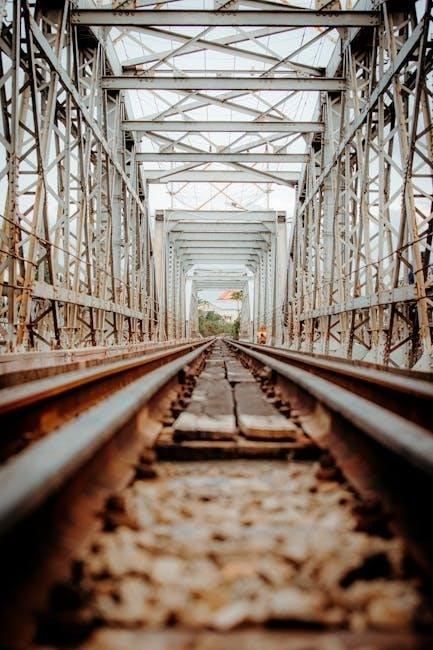
Modern Technologies in Railways
Modern railways employ advanced technologies like AI, IoT, and automation to enhance efficiency, safety, and passenger comfort, ensuring sustainable and reliable transportation solutions globally.
Automation in Railway Operations
Automation in railways has revolutionized operational efficiency, reducing human error and enhancing safety. Automated signaling systems optimize train movements, while AI-driven predictive maintenance ensures equipment reliability. These technologies streamline scheduling, improve punctuality, and reduce costs, enabling railways to handle increasing passenger and freight demands effectively. Automation also supports real-time monitoring, enabling quick responses to disruptions, thus improving overall service quality and passenger satisfaction globally.
Role of AI in Railway Management
AI plays a pivotal role in modern railway management by optimizing operations and enhancing decision-making. From predicting maintenance needs to managing passenger flow, AI algorithms improve efficiency. automated systems analyze data to prevent delays, reduce energy consumption, and ensure safety. AI also personalizes travel experiences through intelligent ticketing and route recommendations. By integrating AI, railways achieve cost savings, improve customer satisfaction, and maintain competitive edge in the transportation sector, driving innovation and sustainability.
Railway Management and Staff
Railway management and staff are crucial for efficient operations, ensuring safety, and providing excellent customer service. Trained professionals maintain smooth functioning, contributing to the success of railway systems globally.
Roles and Responsibilities of Railway Staff
Railway staff play essential roles in ensuring smooth operations. Conductors manage passenger services, engineers operate trains, and station managers oversee daily activities. Maintenance crews ensure track and equipment safety. Customer service representatives assist passengers, while signal operators coordinate train movements. Each role contributes to efficient, safe, and reliable railway services, maintaining high standards for passengers and freight transportation alike.
Training and Certification for Railway Employees
Training and certification are crucial for railway employees to ensure safety and efficiency. Programs are designed by professional educators, focusing on operational skills, safety protocols, and customer service. Employees learn about railway systems, emergency procedures, and technical operations. Certification ensures compliance with industry standards, promoting a competent workforce. Continuous training updates staff on modern technologies and best practices, enhancing overall railway performance and passenger satisfaction.
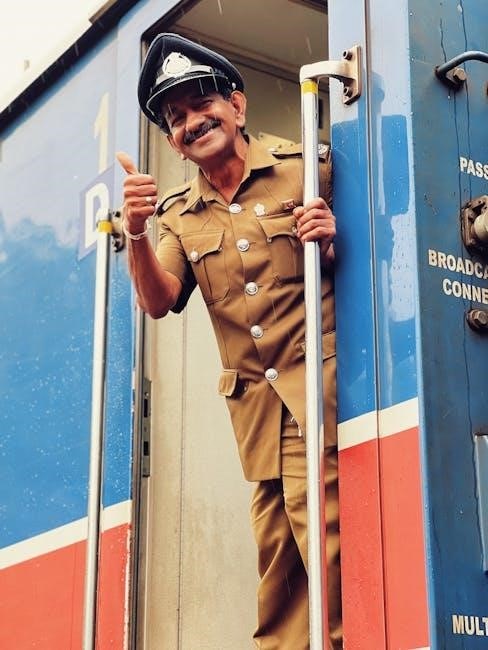
Future of Railways
The future of railways focuses on modern technologies, sustainability, and efficiency. Advances in automation, AI, and green energy will shape tomorrow’s rail systems, ensuring safer and cleaner travel.
Upcoming Trends in Railway Technology
Automation and AI are revolutionizing railway operations, enhancing efficiency and safety. High-speed rail networks are expanding globally, reducing travel times. Sustainable technologies, like hydrogen fuel cells, are being adopted to minimize environmental impact. Modern signaling systems and real-time data analytics are improving punctuality and passenger experiences. These innovations are shaping the future of railways, making them faster, cleaner, and more reliable for generations to come.
Sustainability Initiatives in Railways
Railways are embracing sustainable practices to reduce environmental impact. Initiatives include transitioning to electric and hybrid trains, implementing energy-efficient signaling systems, and using renewable energy sources like solar and wind. Many rail networks aim to achieve net-zero emissions by 2050. Additionally, eco-friendly infrastructure, such as green stations and recycled materials, is being prioritized. These efforts highlight railways’ commitment to a cleaner, more sustainable future, aligning with global climate goals while enhancing passenger and freight services.

Passenger Tips and Etiquette
Respect fellow travelers by giving up seats to those in need and keeping noise levels low. Dispose of trash properly and avoid strong food odors on board.
Essential Items to Carry
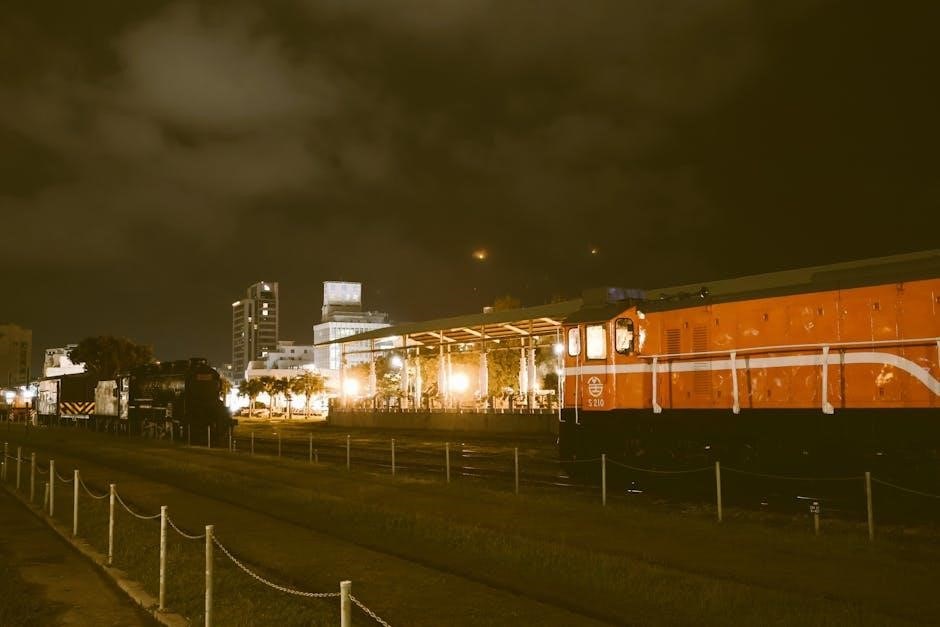
Always pack your ticket, ID, and travel insurance documents. Bring a portable charger, universal adapter, and reusable water bottle. Carry snacks, a first-aid kit, and medications. Include a travel pillow, earplugs, and eye mask for comfort. Wear layers for temperature changes and ensure luggage is secure. Keep valuables close and organize items for easy access. A small notebook and pen can be handy for notes or emergencies during your journey.
Best Practices for Comfortable Travel
Arrive at the station early to avoid last-minute stress. Choose your seat wisely for comfort and view. Keep luggage organized and secure. Stay hydrated and bring snacks. Dress in layers for temperature changes. Use a travel pillow, earplugs, and eye mask for rest. Respect fellow passengers by keeping noise low. Keep essential items within reach and stay informed about delays. Enjoy the journey and embrace the scenic views for a memorable experience.
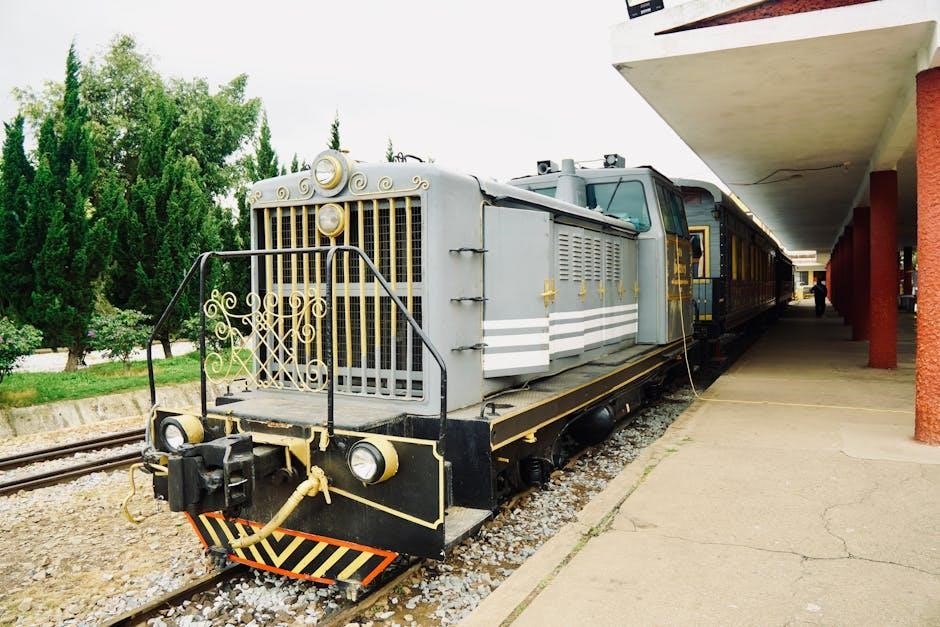
Freight Railway Operations
Freight railways specialize in transporting goods, playing a vital role in global logistics. They ensure efficient, cost-effective movement of commodities, supporting economic growth and international trade networks.
How Freight Railways Work
Freight railways transport goods across long distances, connecting industries and ports. Trains carry commodities like machinery, raw materials, and consumer products. Railcars are loaded at terminals, dispatched via scheduled routes, and unloaded at destinations. Coordination between dispatchers, engineers, and maintenance crews ensures smooth operations. Advanced logistics systems optimize cargo movement, reducing delays. Rail freight is efficient, scalable, and critical for global supply chains, supporting economic growth and international trade.
Importance of Freight Railways in Economy
Freight railways are vital for economic growth, transporting goods efficiently across vast distances. They connect industries to markets, enabling global trade and reducing logistical costs. Rail freight supports supply chains, ensures timely delivery of raw materials, and lowers carbon emissions compared to road transport. This makes freight railways indispensable for sustainable economic development and industrial productivity, fostering international trade and regional connectivity while minimizing environmental impact.

Challenges in Railway Industry
The railway industry faces infrastructure challenges, aging systems, and funding issues. Environmental concerns and operational efficiency also pose significant hurdles, requiring modernization and sustainable solutions to remain competitive.
Infrastructure Challenges
The railway industry faces significant infrastructure challenges, including aging tracks, outdated signaling systems, and maintenance backlogs. These issues can lead to delays, safety risks, and increased operational costs. Additionally, funding constraints and the need for modernization further complicate efforts to improve infrastructure. Addressing these challenges is crucial to ensure efficient and reliable railway operations, especially as demand for rail services continues to grow globally.
Environmental Impact of Railways
Railways play a crucial role in reducing carbon emissions compared to road transport. Sustainable practices, such as electrification and improved energy efficiency, are being adopted. Stricter emissions standards for diesel trains are also reducing environmental impact. Efforts to minimize noise pollution and optimize waste management further contribute to eco-friendly operations. Additionally, railways are increasingly using sustainable materials and implementing biodiversity protection measures along tracks, making them a key player in combating climate change.
Cultural Impact of Railways
Railways have deeply influenced culture, appearing in films, literature, and art. They symbolize progress and connectivity, shaping societies and inspiring creativity. Historical trains and stations are celebrated as heritage symbols.
Railways in Popular Culture
Railways have inspired countless films, books, and songs, symbolizing adventure, freedom, and progress. Movies like The Polar Express and Unstoppable showcase trains as central themes. Literature, such as The Railway Children, highlights their societal impact. Music often uses trains as metaphors for journeys and emotions. Additionally, scenic routes like the Bernina Express are celebrated for their breathtaking views, attracting travelers and inspiring creativity. Railways continue to captivate audiences, embedding themselves deeply in global culture and storytelling.
Historical Landmarks and Heritage Railways
Historical landmarks like the Bernina Express and the Tema-Mpakadan Standard Gauge Railway Line highlight the architectural and cultural significance of railways. Heritage railways, such as steam-powered trains, offer nostalgic journeys, preserving history for future generations. These landmarks attract tourists, showcasing the blend of tradition and innovation. Many heritage routes are restored to their original charm, providing unique travel experiences and educating visitors about the evolution of rail transport;
The Official Railway Guide is an indispensable tool for travelers, blending tradition and innovation. It simplifies journey planning, ensuring efficient and enjoyable experiences for all passengers globally.
The Official Railway Guide serves as a comprehensive resource for travelers and industry professionals. It details railway systems, routes, and schedules, aiding in efficient journey planning. The guide covers historical development, modern technologies, and safety measures. It also highlights the importance of railways in the economy and culture. By integrating traditional and innovative elements, the guide remains a vital tool for understanding and navigating global railway networks effectively.
Final Thoughts on Railway Travel
Railway travel offers a unique blend of comfort, convenience, and scenic beauty, making it a preferred choice for many. The Official Railway Guide simplifies planning, ensuring travelers make informed decisions. From historic routes to modern high-speed lines, railways connect cultures and landscapes. Embracing sustainability and innovation, railways continue to evolve, providing memorable experiences. Whether for leisure or business, railway travel remains a timeless and enriching way to explore the world.